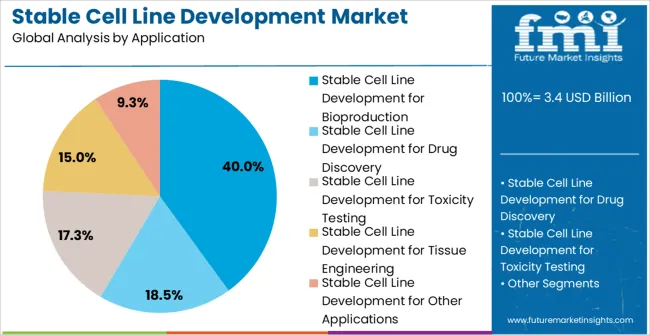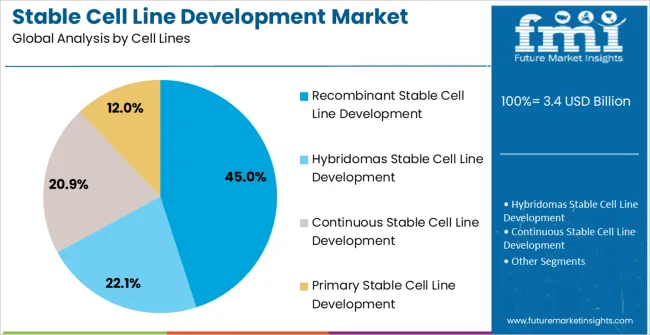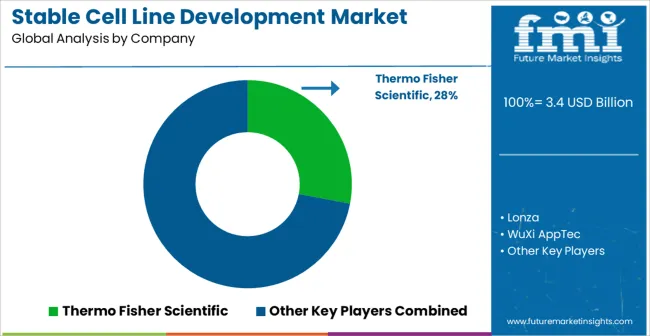The Stable Cell Line Development Market is estimated to be valued at USD 3.4 billion in 2025 and is projected to reach USD 9.5 billion by 2035, registering a compound annual growth rate (CAGR) of 10.8% over the forecast period.

| Metric | Value |
|---|---|
| Stable Cell Line Development Market Estimated Value in (2025 E) | USD 3.4 billion |
| Stable Cell Line Development Market Forecast Value in (2035 F) | USD 9.5 billion |
| Forecast CAGR (2025 to 2035) | 10.8% |
The Stable Cell Line Development market is experiencing steady growth due to its critical role in producing therapeutic proteins, vaccines, and cell-based therapies. The current market scenario is being shaped by increasing demand for biologics, monoclonal antibodies, and gene therapies across both developed and emerging regions. Advances in cell engineering and genome editing technologies are allowing for faster, more efficient development of stable cell lines that meet regulatory standards while reducing time to market.
The market is further supported by the growing need for scalable and reproducible production processes in biopharmaceutical manufacturing. Investments in research and development, along with collaborations between academic institutions and industry players, have accelerated innovation in cell culture techniques.
As the complexity of biologics continues to rise, and personalized medicine gains prominence, the stable cell line development market is expected to expand significantly Enhanced process automation, reduced production costs, and improvements in cell viability are driving adoption, while regulatory bodies increasingly emphasize quality control, offering new avenues for growth across therapeutic and industrial applications.
The stable cell line development market is segmented by source, application, cell lines, end users, and geographic regions. By source, stable cell line development market is divided into Mammalian Stable Cell Line Development and Non-Mammalian Stable Cell Line Development. In terms of application, stable cell line development market is classified into Stable Cell Line Development for Bioproduction, Stable Cell Line Development for Drug Discovery, Stable Cell Line Development for Toxicity Testing, Stable Cell Line Development for Tissue Engineering, and Stable Cell Line Development for Other Applications.
Based on cell lines, stable cell line development market is segmented into Recombinant Stable Cell Line Development, Hybridomas Stable Cell Line Development, Continuous Stable Cell Line Development, and Primary Stable Cell Line Development. By end users, stable cell line development market is segmented into Stable Cell Line Development across Hospitals, Stable Cell Line Development across Research Laboratories, and Stable Cell Line Development for Other End Users. Regionally, the stable cell line development industry is classified into North America, Latin America, Western Europe, Eastern Europe, Balkan & Baltic Countries, Russia & Belarus, Central Asia, East Asia, South Asia & Pacific, and the Middle East & Africa.

The mammalian stable cell line development source segment is expected to hold 60.00% of the Stable Cell Line Development market’s revenue share in 2025, marking it as the dominant source type. This leadership is being attributed to the superior ability of mammalian cells to produce complex proteins with correct folding and post-translational modifications. The segment’s growth has been fostered by increasing demand for biotherapeutics that require high-quality protein expression, such as monoclonal antibodies and vaccines.
The scalability of mammalian cells and their adaptability to various culture systems have further encouraged adoption. Additionally, advances in transfection methods and cell selection technologies have enhanced efficiency and yield, making these systems more viable for large-scale production.
The stringent regulatory requirements for therapeutic products have also emphasized the need for stable mammalian lines that ensure consistency, safety, and reproducibility The segment’s continued expansion is being supported by rising investments in cell culture infrastructure and automation, which are helping biopharmaceutical companies meet global production demands more efficiently.

The application segment of stable cell line development for bioproduction is projected to account for 40.00% of the market revenue in 2025, establishing it as a leading area of focus. The prominence of this segment is being driven by the rising production of biologics, vaccines, and gene therapies that require reliable and reproducible manufacturing platforms. Stable cell lines are being increasingly preferred for large-scale bioproduction due to their capacity for sustained protein expression and predictable performance over extended culture periods.
Improvements in cell line screening and selection processes have enabled faster development cycles, reducing time and cost pressures in drug production pipelines. Additionally, the growing emphasis on regulatory compliance and product quality has highlighted the importance of stable lines in ensuring consistent therapeutic outcomes.
The segment is further benefiting from the expansion of contract development and manufacturing organizations that support bioproduction outsourcing As more companies seek cost-effective, scalable, and compliant production solutions, the demand for stable cell lines optimized for bioproduction is expected to continue rising across the pharmaceutical and biotechnology sectors.

The recombinant stable cell line development segment is anticipated to hold 45.00% of the Stable Cell Line Development market’s revenue share in 2025, making it one of the largest subsegments. The prominence of this segment is being supported by its applications in producing recombinant proteins, enzymes, and other biologics with enhanced functionality. Recombinant technology allows for targeted gene insertion and optimized expression systems, making it possible to achieve higher yields and improved product consistency.
The segment’s growth has been further accelerated by advancements in vector design, gene editing, and selection markers that streamline the development of stable lines with desired traits. Pharmaceutical and biotechnology companies are increasingly adopting recombinant approaches to meet the rising demand for personalized therapies and next-generation biologics. Regulatory agencies have also encouraged the use of recombinant cell lines for their traceability and quality assurance benefits.
Moreover, the segment is benefiting from collaborations between research organizations and industry leaders focused on innovative gene therapies and cell-based treatments As the complexity and variety of biopharmaceutical products expand, recombinant stable cell lines are expected to remain a cornerstone of efficient and compliant production processes.
Stable cell line development is a service that covers the majority of cell cultures. It is primarily used in research and selective diagnosis, and the applications involved in stable cell line development include recombinant protein and antibody production, functional studies, drug screening, gene editing, assay development, and many other platforms.
The procedure entails transferring infected cells to a suitable medium for growth; stability testing is an important step in characterizing cell lines. It ensures the quality of the cell lines produced throughout the passage. The majority of stable cell line development is tailor made in response to institute requirements, ensuring a safe and effective investment. The majority of research activities involving stable cell line development are cancer causes, which makes this market more clinical.
According to the National Cancer Institute at the National Institutes of Health, there were approximately 8.2 million cancer deaths and 14 million new cases in 2025. As a result, efficient stable cell line development is required in modern research activities.

| Country | CAGR |
|---|---|
| China | 14.6% |
| India | 13.5% |
| Germany | 12.4% |
| Brazil | 11.3% |
| USA | 10.3% |
| UK | 9.2% |
| Japan | 8.1% |
The Stable Cell Line Development Market is expected to register a CAGR of 10.8% during the forecast period, exhibiting varied country level momentum. China leads with the highest CAGR of 14.6%, followed by India at 13.5%. Developed markets such as Germany, France, and the UK continue to expand steadily, while the USA is likely to grow at consistent rates. Japan posts the lowest CAGR at 8.1%, yet still underscores a broadly positive trajectory for the global Stable Cell Line Development Market. In 2024, Germany held a dominant revenue in the Western Europe market and is expected to grow with a CAGR of 12.4%. The USA Stable Cell Line Development Market is estimated to be valued at USD 1.2 billion in 2025 and is anticipated to reach a valuation of USD 1.2 billion by 2035. Sales are projected to rise at a CAGR of 0.0% over the forecast period between 2025 and 2035. While Japan and South Korea markets are estimated to be valued at USD 159.5 million and USD 85.5 million respectively in 2025.

| Item | Value |
|---|---|
| Quantitative Units | USD 3.4 Billion |
| Source | Mammalian Stable Cell Line Development and Non-Mammalian Stable Cell Line Development |
| Application | Stable Cell Line Development for Bioproduction, Stable Cell Line Development for Drug Discovery, Stable Cell Line Development for Toxicity Testing, Stable Cell Line Development for Tissue Engineering, and Stable Cell Line Development for Other Applications |
| Cell Lines | Recombinant Stable Cell Line Development, Hybridomas Stable Cell Line Development, Continuous Stable Cell Line Development, and Primary Stable Cell Line Development |
| End Users | Stable Cell Line Development across Hospitals, Stable Cell Line Development across Research Laboratories, and Stable Cell Line Development for Other End Users |
| Regions Covered | North America, Europe, Asia-Pacific, Latin America, Middle East & Africa |
| Country Covered | United States, Canada, Germany, France, United Kingdom, China, Japan, India, Brazil, South Africa |
| Key Companies Profiled | Thermo Fisher Scientific, Lonza, WuXi AppTec, Merck KGaA (MilliporeSigma), BPS Bioscience, Promega Corporation, Eurofins DiscoverX, and Bio-Techne |
The global stable cell line development market is estimated to be valued at USD 3.4 billion in 2025.
The market size for the stable cell line development market is projected to reach USD 9.5 billion by 2035.
The stable cell line development market is expected to grow at a 10.8% CAGR between 2025 and 2035.
The key product types in stable cell line development market are mammalian stable cell line development and non-mammalian stable cell line development.
In terms of application, stable cell line development for bioproduction segment to command 40.0% share in the stable cell line development market in 2025.






Our Research Products

The "Full Research Suite" delivers actionable market intel, deep dives on markets or technologies, so clients act faster, cut risk, and unlock growth.

The Leaderboard benchmarks and ranks top vendors, classifying them as Established Leaders, Leading Challengers, or Disruptors & Challengers.

Locates where complements amplify value and substitutes erode it, forecasting net impact by horizon

We deliver granular, decision-grade intel: market sizing, 5-year forecasts, pricing, adoption, usage, revenue, and operational KPIs—plus competitor tracking, regulation, and value chains—across 60 countries broadly.

Spot the shifts before they hit your P&L. We track inflection points, adoption curves, pricing moves, and ecosystem plays to show where demand is heading, why it is changing, and what to do next across high-growth markets and disruptive tech

Real-time reads of user behavior. We track shifting priorities, perceptions of today’s and next-gen services, and provider experience, then pace how fast tech moves from trial to adoption, blending buyer, consumer, and channel inputs with social signals (#WhySwitch, #UX).

Partner with our analyst team to build a custom report designed around your business priorities. From analysing market trends to assessing competitors or crafting bespoke datasets, we tailor insights to your needs.
Supplier Intelligence
Discovery & Profiling
Capacity & Footprint
Performance & Risk
Compliance & Governance
Commercial Readiness
Who Supplies Whom
Scorecards & Shortlists
Playbooks & Docs
Category Intelligence
Definition & Scope
Demand & Use Cases
Cost Drivers
Market Structure
Supply Chain Map
Trade & Policy
Operating Norms
Deliverables
Buyer Intelligence
Account Basics
Spend & Scope
Procurement Model
Vendor Requirements
Terms & Policies
Entry Strategy
Pain Points & Triggers
Outputs
Pricing Analysis
Benchmarks
Trends
Should-Cost
Indexation
Landed Cost
Commercial Terms
Deliverables
Brand Analysis
Positioning & Value Prop
Share & Presence
Customer Evidence
Go-to-Market
Digital & Reputation
Compliance & Trust
KPIs & Gaps
Outputs
Full Research Suite comprises of:
Market outlook & trends analysis
Interviews & case studies
Strategic recommendations
Vendor profiles & capabilities analysis
5-year forecasts
8 regions and 60+ country-level data splits
Market segment data splits
12 months of continuous data updates
DELIVERED AS:
PDF EXCEL ONLINE
Cell Line Development Market Analysis – Growth & Industry Outlook 2025 to 2035
Cell Line Development Services Market Growth – Trends & Forecast 2025 to 2035
Insect Cell Lines Market - Growth, Applications & Forecast 2025 to 2035
Online Leadership Development Program Market Forecast and Outlook 2025 to 2035
Cell Culture Media & Cell Lines Market Size and Share Forecast Outlook 2025 to 2035
Nanocrystalline cellulose Market Size and Share Forecast Outlook 2025 to 2035
Microcrystalline Cellulose Market Size and Share Forecast Outlook 2025 to 2035
Monocrystalline Solar Cell Market Size and Share Forecast Outlook 2025 to 2035
Cryopreservation Cell Lines Market
Cellulose Diacetate Film Market Size and Share Forecast Outlook 2025 to 2035
Lined Dip Pipes Market Size and Share Forecast Outlook 2025 to 2035
Cellulose Fiber Market Forecast and Outlook 2025 to 2035
Linear Regulator ICs (LDOs) Market Forecast and Outlook 2025 to 2035
Line Post Porcelain Insulator Market Size and Share Forecast Outlook 2025 to 2035
Cellulite Treatment Market Size and Share Forecast Outlook 2025 to 2035
Cellulose Derivative Market Size and Share Forecast Outlook 2025 to 2035
Linerless Label Market Size and Share Forecast Outlook 2025 to 2035
Cellulose Film Packaging Market Size and Share Forecast Outlook 2025 to 2035
Cell Therapy Systems Market Size and Share Forecast Outlook 2025 to 2035
Cellular IoT Market Size and Share Forecast Outlook 2025 to 2035

Thank you!
You will receive an email from our Business Development Manager. Please be sure to check your SPAM/JUNK folder too.
Chat With
MaRIA